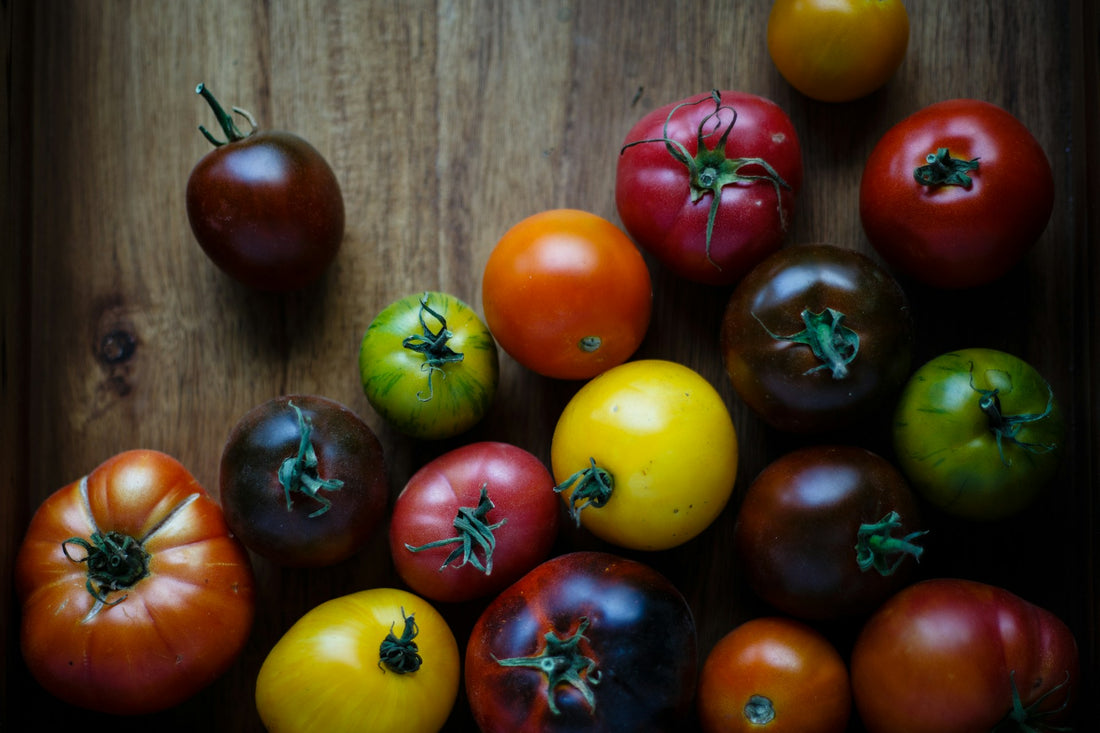The historic, open-pollinated absolutely delicious heirloom tomato varieties offer a sensory experience that far surpasses the bland, uniform tomatoes found in most grocery stores. Growing heirloom tomatoes is a little bit trickier than other tomato types, but it is completely worth it!
What Are Heirloom Tomatoes?
Heirloom tomatoes are a unique breed of tomatoes that have been passed down through generations, preserving their distinct characteristics and flavors. Unlike modern hybrid varieties, heirlooms are open-pollinated, meaning they can be saved and replanted year after year, ensuring that the same variety is maintained. These tomatoes are often defined by their age, with some varieties dating back over a century. Many have been passed down through families and cultures for generations.
Heirloom Tomato Varieties
From the deep, almost-black hues of 'Black Krim' to the striking stripes of 'Green Zebra,' these tomatoes delight the eye and tantalize the taste buds. Some popular heirloom varieties include the classic 'Brandywine,' known for its large, ridged fruits and exceptional flavor; the rich, complex 'Cherokee Purple;' the tangy-sweet 'Amish Paste;' and the diminutive yet flavor-packed 'Black Cherry.' We carry a true classic, the Italian Roma Heirloom, used for decades for canning and making tomato paste.
Heirloom Tomato Care
-
Soil Preparation and Amendments
Heirloom tomatoes thrive in well-drained, nutrient-rich soil. Before planting, amend your garden beds with compost or aged manure to enhance the soil's fertility and water-holding capacity. Maintaining a slightly acidic pH, between 5.8 and 6.8, is also important for optimal nutrient uptake.
-
Light and Temperature Requirements
Heirloom tomatoes are sun-loving plants, requiring a minimum of six hours of direct sunlight per day,. Some experts recommend eight hours or more. Be mindful of your local climate, as many heirloom varieties prefer cooler growing conditions, especially during the hot summer months. Providing shade or using mulch can help regulate soil temperatures and prevent stress.
-
Watering and Moisture Management
Consistent moisture is crucial for heirloom tomatoes, as fluctuations in water availability can lead to problems like blossom-end rot or cracking. Aim to keep the soil consistently moist, but not waterlogged, and consider using mulch to help retain moisture and suppress weeds.
-
Pruning and Staking
Indeterminate heirloom tomato varieties, which continue growing and producing fruit throughout the season, always benefit from pruning and staking. Removing suckers (side shoots) and tying the main stems to a trellis or cage can improve air circulation, reduce disease, and support the plant's heavy fruit load.
-
Fertilization and Nutrient Needs
Heirloom tomatoes are heavy feeders, requiring regular fertilization to maintain their vigor and productivity. Opt for a balanced, tomato-specific fertilizer, applying it according to the manufacturer's instructions. Avoid over-fertilizing, as excessive nitrogen can lead to lush foliage at the expense of fruit development.
Starting Heirloom Tomatoes from Seed
If you're starting heirloom tomatoes from seed, plan to sow them indoors 6-8 weeks before your last expected frost date. Use a well-draining seed starting mix and provide the seedlings with ample light, warmth, and consistent moisture. Gradually acclimate the young plants to outdoor conditions before transplanting them into your garden.
Heirloom Tomato Challenges and How To Overcome Them
Disease and Pest Management
Heirloom tomatoes often are more susceptible to certain diseases and pests compared to modern hybrids. Common problems include bacterial wilt, early blight, late blight, and various fungal infections. Vigilant monitoring, crop rotation, and the use of organic or natural pest control methods can help mitigate these challenges.
Dealing with Cracking and Blossom-End Rot
Inconsistent moisture levels can lead to issues like fruit cracking and blossom-end rot. Maintaining consistent soil moisture, providing adequate calcium, and avoiding sudden changes in watering can help prevent these problems.
Addressing Irregular Growth and Deformities
Heirloom tomatoes may sometimes exhibit unusual growth patterns or fruit deformities, such as irregular shapes or asymmetrical development. While these quirks are part of the charm of heirloom varieties, they can be prevented by addressing the underlying causes, like temperature fluctuations or nutrient imbalances.
Tips For A Successful Heirloom Tomato Harvest
- Set up the stakes or trellis before the plants get too unwieldy. Heirloom varieties are indeterminate with a spreading growth habit and don't have natural resistance to some of the diseases. Once a leaf or tomato touches the ground, it may have picked up a disease spore. Don't let the plants sprawl out horizontally; make them grow vertically.
- Mulch well underneath the plants. When it rains, it can splash soil onto the tomato leaves and bring diseases from the soil to the plant. Between the mulch and trellising, the plant's leaves are better protected from potential diseases.
- Cover the tomato beds with compost the season prior to planting. The gives the soil time to soak up and integrate the nutrients so it'll be primed and ready for planting in the spring.
- Don't pick tomatoes when they're wet. When they're wet, they've absorbed a lot of water and don't taste as good. It's best to wait 1-2 days after rain to pick them.
- Find the right tomato for your region. Remember, these are tomatoes developed by farmers for their specific regions, then passed on to family and neighbors over time. Each variety is specifically adapted to a particular area. Many can be grown outside their original region, but you'll have the best luck with local ones. Regional growing conditions can also affect flavor.



